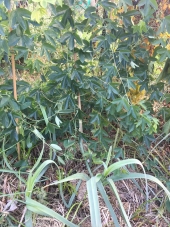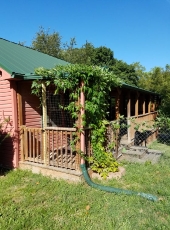
 2
2




 3
3








 2
2




 1
1




Permaculture...picking the lock back to Eden since 1978.
Pics of my Forest Garden
 1
1








Permaculture...picking the lock back to Eden since 1978.
Pics of my Forest Garden




 1
1




Mandrake...takes on and holds the influence
of the devil more than other herbs because of its similarity
to a human. Whence, also, a person’s desires, whether good
or evil, are stirred up through it...
-Hildegard of Bingen, Physica
 2
2




 1
1




P. lutea is hardy to zone 5 here in the US. P. incarnata and P. caerulea are hardy to zone 6. Tropical P. edulis hardy to zone 9.
Incarnata and caerulea have a well known hybrid called Colvillii which is noted as surviving temperatures as low as -15F, which corresponds with zone 5.
 4
4




 1
1




If there is one thing the Wizard of Oz has taught me, it is not to trust school teachers on bicycles.
 2
2




Kārlis Taurenis wrote:Breeding hardy passifloras! Fascinating topic. Yet it seems imperative to get fully clear on passiflora hardiness to understand the implications.
Some of this is fairly contrary to my understanding. P.caerulea is sometime quoted as being hardy to zone 6 (-10°F or -24°C) but other sources such as PFAF - https://pfaf.org/User/plant.aspx?latinname=Passiflora+caerulea - state zone 9 (20°F or -7°C). A huge difference!!! What is the truth?
From seeing them only marginally surviving where I'm from in Southwest England, I'd say they're hardy to around zone 9 or probably zone 8 for well established specimens.
 3
3




Brendan Brown. wrote:https://www.ourfigs.com/forum/blueberry-home/1238943-my-ontario-non-fig-experiments/page2#post1407769
P. Caerula and Incarnata are being grown in Ontario here. Both seem to come back from the ground. THis is zone 5.
I am growing p. Incarnata in zone 6 massachusetts. It grows as an herbaceous perennial, but is very vigorous.




Nathan Yospe wrote:
I'm not certain of the full range of P. caerulea, but I have seen well established plants thriving in Northern suburbs of Seattle, Washington, at least one of which was in a zone 7a spot. However, they reportedly only set fruit on years with either mild winters or early thaws.

|
Whatever you say buddy! And I believe this tiny ad too:
Rocket Mass Heater Resources Wiki
https://permies.com/w/rmh-resources
|



